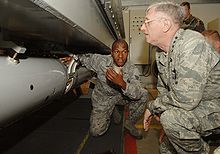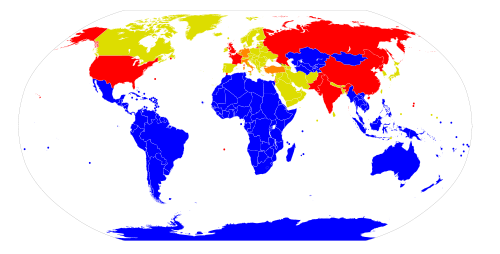- Nuclear sharing
-
Nuclear sharing is a concept in NATO's policy of nuclear deterrence, which involves member countries without nuclear weapons of their own in the planning for the use of nuclear weapons by NATO, and in particular provides for the armed forces of these countries to be involved in delivering these weapons in the event of their use.
As part of nuclear sharing, the participating countries carry out consultations and take common decisions on nuclear weapons policy, maintain technical equipment required for the use of nuclear weapons (including warplanes capable of delivering them), and store nuclear weapons on their territory.
Of the three nuclear powers in NATO (France, the United Kingdom and the United States), only the United States has provided weapons for nuclear sharing. As of November 2009[update], Belgium, Germany, Italy, the Netherlands and Turkey are still hosting U.S. nuclear weapons as part of NATO's nuclear sharing policy.[1][2] Canada hosted weapons until 1984,[3] and Greece until 2001.[1][4] The United Kingdom also received U.S. tactical nuclear weapons such as nuclear artillery and Lance missiles until 1992, despite the UK being a nuclear weapons state in its own right; these were mainly deployed in Germany.
In peace time, the nuclear weapons stored in non-nuclear countries are guarded by U.S. soldiers; the codes required for detonating them are under American control. In case of war, the weapons are to be mounted on the participating countries' warplanes. The weapons are under custody and control of USAF Munitions Support Squadrons co-located on NATO main operating bases who work together with the host nation forces.[1]
 A U.S. nuclear weapon storage system at Volkel Air Base to store weapons for delivery by Royal Netherlands Air Force F-16s
A U.S. nuclear weapon storage system at Volkel Air Base to store weapons for delivery by Royal Netherlands Air Force F-16s
As of 2005[update], 180 tactical B61 nuclear bombs of the 480 U.S. nuclear weapons believed to be deployed in Europe fall under the nuclear sharing arrangement.[5] The weapons are stored within a vault in Hardened Aircraft Shelters, using the USAF WS3 Weapon Storage and Security System. The delivery warplanes used are F-16s and Panavia Tornados.
Historically, the shared nuclear weapon delivery systems were not restricted to bombs. Greece used Nike-Hercules Missiles as well as A-7 Corsair II attack aircraft. Canada had Bomarc nuclear-armed anti-aircraft missiles, Honest John surface-to-surface missiles and the AIR-2 Genie nuclear-armed air-to-air rocket, as well as tactical nuclear bombs for the CF-104 fighter.[3]
After the Soviet Union collapsed, the nuclear weapon types shared within NATO were reduced to tactical nuclear bombs deployed by Dual-Capable Aircraft (DCA).[1]
The only German nuclear base is located in Büchel, near the border to Luxembourg. The base has 11 Protective Aircraft Shelters (PAS) equipped with WS3 Vaults for storage of nuclear weapons (maximum capacity of 44). There are 20 B61 nuclear bombs stored on the base for delivery by German PA-200 Tornado IDS bombers of the JaBoG 33 squadron. By 2015 Germany's Tornado IDS aircraft are due to be retired, and it is unclear what nuclear sharing role, if any, Germany will then retain.[1]
Nuclear Non-Proliferation Treaty considerations
Both the Non-Aligned Movement and critics inside NATO believe that NATO's nuclear sharing violates Articles I and II of the Nuclear Non-Proliferation Treaty (NPT), which prohibit the transfer and acceptance, respectively, of direct or indirect control over nuclear weapons.
The US insists that its forces control the weapons, and that no transfer of the nuclear bombs or control over them is intended "unless and until a decision were made to go to war, at which the NPT treaty would no longer be controlling", so there is no breach of the NPT.[6] However, the pilots and other staff of the "non-nuclear" NATO countries practice handling and delivering the US nuclear bombs, and non-US warplanes have been adapted to deliver US nuclear bombs which involved the transfer of some technical nuclear weapons information. Even if the US argument is considered legally correct, some[who?] argue such peacetime operations appear to contravene both the objective and the spirit of the NPT. Essentially, all preparations for waging nuclear war have already been made by supposedly non-nuclear weapon states.
At the time the NPT was being negotiated, the NATO nuclear sharing agreements were secret. These agreements were disclosed to some of the states, including the Soviet Union, negotiating the treaty along with the NATO arguments for not treating them as proliferation. Most of the states that signed the NPT in 1968 would not have known about these agreements and interpretations at that time.[7]
See also
- 1958 US-UK Mutual Defence Agreement
- United States military deployments around the world
References
- ^ a b c d e Malcolm Chalmers and Simon Lunn (March 2010), NATO’s Tactical Nuclear Dilemma, Royal United Services Institute, http://www.rusi.org/publications/occasionalpapers/ref:O4B991ABDC4148/, retrieved 2010-03-16.
- ^ Der Spiegel: Foreign Minister Wants US Nukes out of Germany (2009-04-10)
- ^ a b John Clearwater (1998), Canadian Nuclear Weapons: The Untold Story of Canada's Cold War Arsenal, Dundurn Press Ltd, ISBN 1550022997, http://books.google.com/?id=5-R7EJ0r680C, retrieved 2008-11-10
- ^ Hans M. Kristensen (February 2005), U.S. Nuclear Weapons in Europe, Natural Resources Defense Council, p. 26, http://www.nrdc.org/nuclear/euro/euro.pdf, retrieved 2009-04-02
- ^ Hans M. Kristensen (February 2005), U.S. Nuclear Weapons in Europe, Natural Resources Defense Council, http://www.nrdc.org/nuclear/euro/euro.pdf, retrieved 2009-04-02
- ^ Brian Donnelly, Foreign and Commonwealth Office, The Nuclear Weapons Non-Proliferation Articles I, II and VI of the Treaty on the Non-Proliferation of Nuclear Weapons, Agency for the Prohibition of Nuclear Weapons in Latin America and the Caribbean, http://www.opanal.org/Articles/cancun/can-Donnelly.htm, retrieved 2009-08-07
- ^ Laura Spagnuolo (23 April 2009), NATO nuclear burden sharing and NPT obligations, British American Security Information Council, http://www.basicint.org/sites/default/files/gtz13.pdf, retrieved 2009-08-07
External links
- U.S. Nuclear Weapons in Europe, Hans M. Kristensen, Natural Resources Defense Council, February 2005
- NATO Nuclear Sharing and the NPT - Questions to be Answered, joint PENN/BASIC-BITS-CESD-ASPR Research Note 97.3, June 1997
- Questions of Command and Control: NATO, Nuclear Sharing and the NPT, PENN Research Report 2000.1, Martin Butcher et al., 2000
- Nuclear Sharing in NATO: Is it Legal?, Otfried Nassauer, Institute for Energy and Environmental Research, May 2001
- Questions of Command and Control: NATO, Nuclear Sharing and the NPT, Project on European Nuclear Non-Proliferation, March 2000
- NATO Nuclear Power Sharing and the NPT, Denise Groves, Berlin Information-center for Transatlantic Security, 6 August 2000
- NATO's Positions Regarding Nuclear Non-Proliferation, Arms Control and Disarmament and Related Issues, NATO, June 2005
- United States Air Forces in Europe - Munitions Support Squadron, GlobalSecurity.org
- Statement on behalf of the non-aligned state parties to the Treaty on the Non-Proliferation of Nuclear Weapons, 2 May 2005
- Opposition to Nuclear Sharing Leads to Proposed Senate Amendment on NATO Expansion, British American Security Information Council, May 1998
- NPT à la Carte? NATO and Nuclear Non-Proliferation, Nicola Butler, Acronym Institute, 2005
- A Constructed Peace: The Making of the European Settlement, 1945-1963 (Chapter 5: Eisenhower and Nuclear Sharing), Marc Trachtenberg, 1999, Princeton University Press, ISBN 0691002738
- Commitment to purpose : how alliance partnership won the cold war, Richard L. Kugler, RAND, MC-190-RC/FF, 1993, ISBN 0-8330-1385-8
Categories:- Nuclear weapons policy
- NATO
Wikimedia Foundation. 2010.

